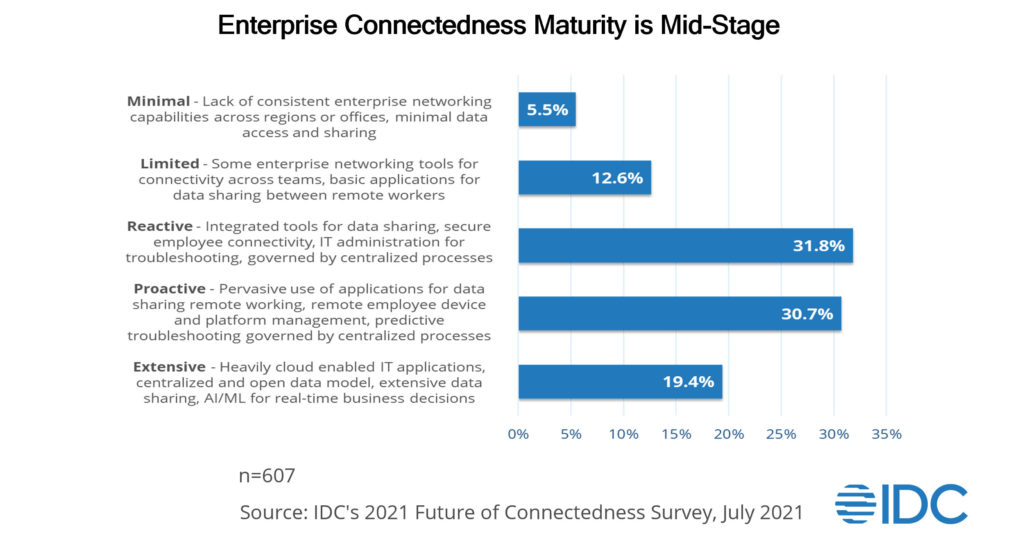IT organizations are under tremendous pressure to deliver on the promise of the digital business model. As organizations become increasingly digital, guaranteeing a reliable digital connection for both internal and external parties is now critical to business continuity. Any connectivity disruption can have a dramatic impact on revenues, partner engagement and customer experience and satisfaction.
Forced to pivot and adapt in 2020, organizations quickly learned that they must now deliver and execute on a resilient connectivity strategy that provides uninterrupted bandwidth to keep business operations running smoothly. Organizations must be able to respond, adapt and evolve based on real-time and future connectivity demands – and this adaptation should extend beyond the network.
In IDC’s recent report, IDC Future Scape: Worldwide Future of Connectedness 2022 Predictions, we predict that more than 30% of organizations will prioritize connectivity resiliency to ensure business continuity, resulting in uninterrupted digital engagement for customers, employees and partners in 2022. Based on recent survey data from IDC’s Future of Connectedness survey, connectivity resiliency is aligned to state of connectedness across the enterprise. Currently, almost half of enterprises are still mid-stage or younger in their overall maturity strategy.
Even as we hopefully watch the world return to some newer state of normal this year, this prediction percentage should be higher. It should in fact be a wake-up call to any enterprise that looks to effectively manage its distributed workforce effectively as they further adopt digital-first principles. The business outcomes will be the faster ability to adapt to business and market conditions, adopt new technologies to improve business agility, and adapt to market changes.

Connectivity resiliency isn’t a one-time transformation. It requires the continuous alignment of people, processes, and technology around a common goal of guaranteed uptime. It also requires investment and integration of complementary connectivity technologies that empower users and customers to remain connected to key applications and services regardless of location or issue. The business outcomes will be the faster ability to adapt to changing business and market conditions and the adoption of new technologies to improve agility.
The Roadmap to Connectivity Resiliency
Enterprises must first assess their current network, IT, cloud and application footprint to get a full understanding of how people, processes, systems, and “things” interact, and the actions needed to address potential technology related issues. Here, enterprises should perform an internal gap analysis to assess existing connectivity capabilities, strengths, weaknesses, and priorities for the entire organization. This should include:
- Network access capabilities and needs
- Usage patterns of on-premises and hosted applications
- Determining acceptable service level assurances associated with the disruption of business operations.
Second, organizations should prioritize investment and integration of complementary connectivity technologies that allow users and customers to remain connected to key applications and services regardless of location or issue. This could be via a complementary network, or through cloud solution adoption that allow access/usage anywhere and that eliminate risk of siloed data.
Thirdly, organizations should focus on building automation and analytics into all critical connectivity processes. As organizations use complementary technologies like 5G and WiFi 6 to ensure seamless connectivity, it will be just as critical to leverage data intelligence and performance metrics to track customer engagement, provide notification of issues, remove manual intervention of any hand off, and automate migration requirements between networks or systems.
As organizations evaluate both short and longer term business goals, addressing the resiliency challenge today will help drive opportunities to become more innovative, efficient and creative tomorrow. The end result will be increased agility for the Future Enterprise, with a connectedness outcome that improves network and IT efficiency, keeps employees, customers and partners engaged, helps ensure business continuity, and accelerates time to revenue.
Interested in learning more about IDC’s Future of Connectedness research practice? Download our latest eBook, Value Chain Agility: Connecting Partner Ecosystems to Shared Data and Intelligence




